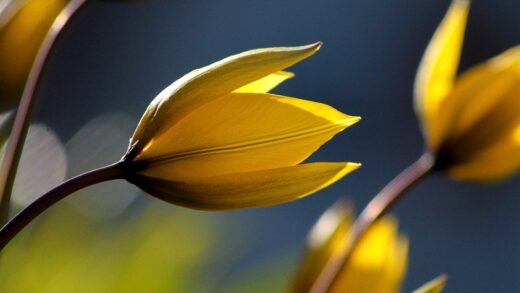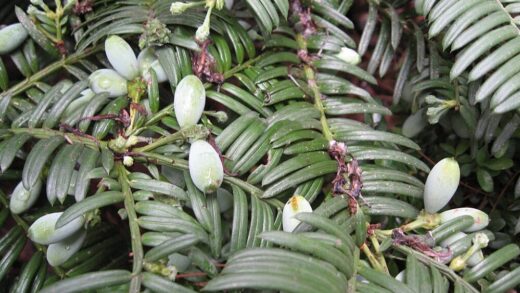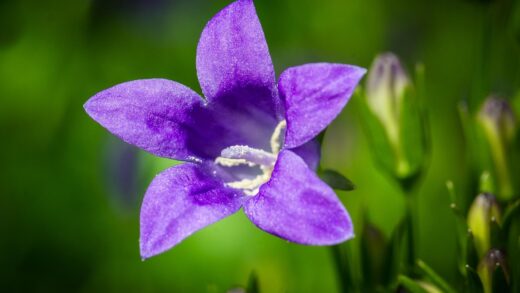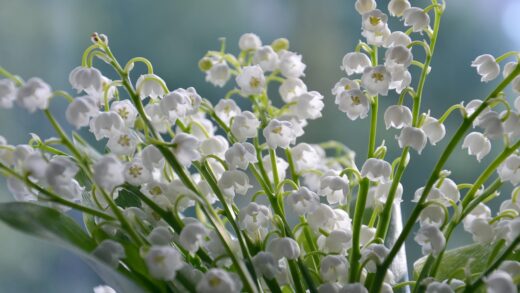Ensuring the Balkan squill successfully navigates the challenges of winter is crucial for its survival and for a spectacular floral display the following spring. This hardy little bulb is naturally well-adapted to cold climates, originating from regions that experience significant winter frost and snow. However, in a garden setting, providing some basic winter protection and ensuring the correct environmental conditions can make a significant difference, particularly for newly planted bulbs or those grown in containers. The primary goals of winter care are to protect the bulbs from the most extreme cold, to prevent them from becoming waterlogged, and to shield them from the physical damage caused by frost heave.
The most critical factor for successful wintering is, without a doubt, the condition of the soil. Balkan squill bulbs are highly intolerant of sitting in cold, wet soil for extended periods. This combination is the perfect recipe for bulb rot, a fungal condition that will quickly destroy the bulbs. Therefore, the preparatory work done in the autumn is paramount. The soil must be free-draining to allow winter rains and melting snow to move away from the bulbs quickly. For gardens with heavy clay soil, amending the planting area with grit and organic matter before planting is a non-negotiable step for long-term survival.
Once the drainage is assured, the next consideration is insulation. While the bulbs are dormant underground, they are vulnerable to extreme and fluctuating temperatures. A consistent blanket of snow is an excellent natural insulator, keeping the soil temperature stable. However, in winters with little snow cover, the soil can be exposed to repeated cycles of freezing and thawing. This process, known as frost heave, can damage the developing roots and even push the small bulbs up out of the soil, exposing them to the harsh winter air and desiccating winds.
To mitigate these risks, the application of a winter mulch is a highly recommended practice. A layer of organic material applied to the soil surface in late autumn, after the ground has started to cool but before it freezes solid, provides an effective insulating layer. This mulch helps to moderate the soil temperature, keeping it more stable and reducing the risk of frost heave. It also helps to conserve a moderate amount of moisture, preventing the soil from completely drying out in cold winter winds, and it has the added benefit of suppressing early spring weeds. Proper wintering is about creating a stable, protected, and well-drained environment for the dormant bulbs.
Preparing for dormancy
The preparation for winter begins long before the first frosts arrive. It starts in the late summer and early autumn as the Balkan squill enters its dormant period. A crucial aspect of this preparation is ensuring the bulbs have had a warm and relatively dry summer. This period of ‘baking’ in the sun helps the bulbs to properly ripen and mature, which strengthens them and prepares them for the coming cold. If the bulbs have been in consistently damp soil throughout the summer, they enter the winter in a weakened state and are far more susceptible to rot and frost damage.
More articles on this topic
As autumn approaches, it is important to tidy the area where the bulbs are planted. Remove any summer-flowering annuals that have finished, and gently clear away any fallen leaves or other debris that has accumulated on the soil surface. This cleanup is not just for aesthetic reasons; it removes potential hiding places for slugs, snails, and other pests that might overwinter and damage the emerging shoots in the spring. It also improves air circulation over the soil surface, which can help to prevent the conditions that favor fungal diseases.
This is also the time to ensure that your bulb plantings are clearly marked. Once the foliage has died back, the bulbs are invisible, and it is very easy to forget their exact location. Placing a durable label or a small stake in the ground will prevent you from accidentally digging into the dormant bulbs while planting other autumn plants or turning over the soil. This simple act of marking the spot can save you from inadvertently destroying your precious clumps of squill.
Finally, before applying any winter mulch, a final check of the soil conditions is advisable. If the autumn has been particularly dry, it may be beneficial to give the area a deep and thorough watering. This ensures that the soil has adequate moisture for the bulbs to begin their root development before the ground freezes. The bulbs will be actively growing roots throughout the autumn and early winter, even when there is no visible top growth, so providing them with this initial moisture is an important step in setting them up for successful overwintering.
The role of mulching
Applying a layer of mulch in late autumn is one of the most beneficial actions you can take to protect your Balkan squill bulbs over the winter. The primary purpose of this mulch is not to keep the soil warm, but rather to keep it at a more stable and consistent temperature. It acts as an insulating blanket, buffering the soil from the extreme fluctuations between day and night temperatures and from the damaging effects of repeated freeze-thaw cycles. This stability is crucial for protecting the delicate new roots that the bulbs are developing throughout the autumn.
More articles on this topic
The ideal time to apply the winter mulch is in late autumn or early winter, after the first light frosts have occurred but before the ground freezes solid. Applying the mulch too early, while the soil is still warm, can trap heat and moisture, potentially encouraging rot and preventing the bulbs from entering full dormancy. Waiting for the soil to cool ensures that the mulch serves its intended purpose of insulation against the deep cold of winter. A layer of about 3 to 5 centimeters is generally sufficient to provide adequate protection.
A wide variety of organic materials can be used for mulching. Well-rotted leaf mold is an excellent choice, as it is light, airy, and breaks down over the winter to enrich the soil. Shredded bark, compost, or even pine straw are also very effective options. Avoid using heavy, dense materials like wet leaves or grass clippings, as these can become compacted over the winter, trapping too much moisture and impeding air circulation, which could lead to the bulbs rotting. The ideal mulch provides insulation while still allowing the soil to breathe.
Beyond temperature regulation, the winter mulch serves several other useful purposes. It helps to conserve soil moisture, preventing the ground from drying out completely during cold, windy periods. As the organic material slowly decomposes, it releases valuable nutrients into the soil, providing a gentle feed for the bulbs in the spring. Furthermore, the mulch layer helps to suppress the germination and growth of winter and early spring weeds, ensuring that when your Balkan squill emerges, it does not have to compete for light and resources.
Winter care for container-grown bulbs
Balkan squill grown in pots and containers require a different approach to winter care, as they are far more vulnerable to the cold than their counterparts in the ground. The soil in a container is exposed to the cold air on all sides, meaning it can freeze much more quickly and deeply than the insulated soil in a garden bed. This can be fatal for the bulbs, as the roots can be killed by the extreme cold, and the expansion of the freezing soil can even crack terracotta pots. Therefore, providing adequate insulation is absolutely essential.
There are several effective methods for protecting container-grown bulbs. One simple option is to move the pots to a more sheltered location, such as against a house wall or into an unheated garage, shed, or cold frame for the coldest part of the winter. This will protect them from the worst of the winter winds and precipitation. If the pots must be left in an exposed location, they can be insulated by wrapping them in bubble wrap or several layers of horticultural fleece. Grouping several pots together can also help to create a larger thermal mass that freezes more slowly.
Another technique is to ‘plunge’ the pots into the ground. This involves digging a hole in a spare patch of garden soil and sinking the entire pot into the ground up to its rim. The surrounding soil then provides excellent natural insulation, protecting the pot and the bulbs within it from the harshest temperature fluctuations. Alternatively, the pots can be placed inside a larger container, with the gap between the two pots being packed with an insulating material like straw, shredded leaves, or bark chippings.
Watering during the winter is a delicate balance for container-grown bulbs. The compost should not be allowed to dry out completely, but it is equally important that it does not become waterlogged. In a sheltered location like a cold frame, the compost will need to be checked periodically throughout the winter and watered sparingly only if it begins to feel dry. The goal is to keep the compost just barely moist to the touch. Proper winter protection for container-grown Balkan squill is a critical step to ensure their survival and a beautiful display in the spring.
Signs of winter damage
Despite your best efforts, it is possible for Balkan squill to suffer from winter damage, especially during an unusually harsh or wet winter. It is useful to know what signs to look for in the spring, as this can help you to diagnose any problems and adjust your future cultivation practices. The most obvious sign of a problem is a complete failure of the bulbs to emerge in the spring. If your squill do not show any signs of life by the time they would normally be in full growth, it is highly likely that the bulbs have succumbed to rot over the winter.
If you gently dig into the soil where the bulbs were planted and find only soft, mushy, or completely disintegrated remains, then waterlogged soil and bulb rot were the culprits. This indicates that the soil drainage is inadequate for the needs of the plant. In the future, you will need to improve the drainage by adding more grit and organic matter, or consider moving the bulbs to a different location in the garden, such as a raised bed or a sloping site where water naturally drains away more effectively.
Another symptom of winter damage is the emergence of weak, stunted, or yellowed growth. The shoots may appear, but they lack vigor and may fail to develop properly or produce flowers. This can be a sign of partial rot, where the bulb has survived but has been significantly weakened. It can also be a symptom of damage from frost heave, where the developing roots have been torn or stressed by the movement of the soil. While these bulbs may recover in subsequent years if given good care, their performance in the current season will be poor.
Finally, you may notice physical damage to the emerging shoots and leaves caused by pests like slugs, which can be active during mild spells in the winter, or from the freezing of tender new growth during a late frost. While this type of damage is often superficial and the plant will usually grow through it, a severe late frost can sometimes damage the developing flower buds, leading to a reduction in the floral display. Being able to recognize these signs of winter damage allows you to understand the challenges your plants have faced and to take steps to provide them with better protection in the future.


















